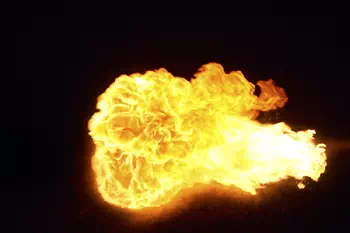Incinerators
Until the mid-1990’s, hospital/medical/infection waste incinerators (HMIWIs) were installed at many U.S. hospitals, other healthcare facilities, and commercial waste disposal companies. They were used to burn infectious wastes, together with a variety of other wastes that found their way into the infectious waste stream.
But while medical incinerators may have helped deal with one problem, they created several others. Medical incinerators were found to be significant sources of airborne mercury. In addition, in 1994, EPA’s Draft Dioxin Reassessment identified medical waste incineration as the single largest source of dioxin air pollution. Pressure from environmental and community groups eventually conviced most healthcare facilities to re-examine their practices. Since 1997, the number licensed HMIWI units dropped from 2,400 to only 111 (2004), a 95% reduction. Several factors have contributed to this decline:
- Increasing environmental awareness among healthcare facilities (no doubt stimulated by public concern) has led to improved waste practices, including segregation and non-incineration treatment and disposal of non-regulated wastes.
- Clean Air Act (CAA) regulations finalized in 1997 for HMIWIs increased the cost, compliance burden, and potential liability associated with maintaining onsite incineration facilities.
- In addition to CAA compliance costs, the expenses of equipment upkeep, labor, and energy have continued to increase.
- Several treatment technologies not involving combustion (e.g., autoclave, microwave, chemical and mechanical treatment) have been approved for use in a number of states.
Problems with Incineration: Air Emissions and Energy Use
Incineration is unquestionably effective, and it remains a legal treatment alternative in most states (check your state rules), but it is associated with serious air quality concerns. Because atmospheric oxygen is used as the reagent, a large volume of air must constantly pass through the system. Unless the exhaust air passes through a control device, all substances that are volatile at the operating temperature of the system will be emitted with the exhaust stream. For example, hospital incinerators were once (and, though to a lesser extent in the U.S., continue to be) significant sources of environmental mercury contamination. In addition, the operating conditions inside incinerators can lead to the formation of organochlorine compounds such as dioxins.
Incinerators are also inherently inefficient from an energy standpoint, particularly when dealing with wastes with high water content. To maintain combustion temperatures, many pounds of fuel must be burned to destroy each pound of waste. Much of that energy is spent simply to boil off the water so that the organic portion of the waste will burn. This has historically been less of a consideration for medical waste, since processing costs are high in any case, but will undoubtedly become more of an issue as the cost of fuel (typically natural gas) increases. Moreover, the burning of large quantities of fuel entails the generation of excessive greenhouse gases (primarily carbon dioxide) relative to the amount of waste material destroyed. This is hardly on the radar screen in the U.S. at present, but may also become a significant issue in the not-too-distant future.
For information on hospital/medical/infectious waste incinerators (HMIWI), see the Combustion Portal.
The following P2 suggestions apply both to facilties with on-site incinerators and to those that send their infectious wastes off-site for incineration.
- Segregate wastes at the source to minimize the volume of actual regulated medical waste (RMW). Further, isolate RMW that must be incinerated; depending on state regulations, at least a small portion of biohazardous waste, including sharps, may have to be incinerated. This will likely include pathological wastes and wastes contaminated with small amounts of chemotherapy substances.
- Minimize the quantity of PVC plastics, products, and packaging (which comprise a portion of plastic wastes in healthcare) that are going to incineration. These materials can create dioxins when incinerated. Recycle plastics to the maximum extent possible.
- Do not incinerate mercury wastes, including spill cleanup material.
- Manage CFC-containing wastes separately from incineration wastes.
- Implement alternative technologies for infectious wastes, including autoclaving, hydropulping, pyrolysis, microwave, chemical treatment, and irradiation.
Call your state or local air pollution control agency.
Hospital/Medical/Infectious Waste Incinerators. EPA web site.




